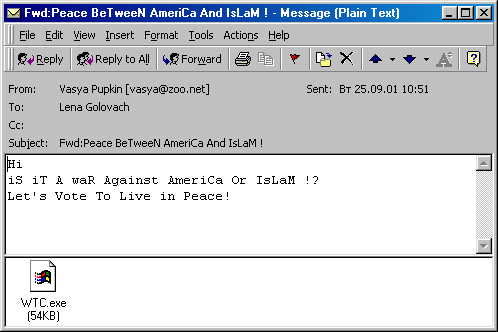Parent class: VirWare
Viruses and worms are malicious programs that self-replicate on computers or via computer networks without the user being aware; each subsequent copy of such malicious programs is also able to self-replicate. Malicious programs which spread via networks or infect remote machines when commanded to do so by the “owner” (e.g. Backdoors) or programs that create multiple copies that are unable to self-replicate are not part of the Viruses and Worms subclass. The main characteristic used to determine whether or not a program is classified as a separate behaviour within the Viruses and Worms subclass is how the program propagates (i.e. how the malicious program spreads copies of itself via local or network resources.) Most known worms are spread as files sent as email attachments, via a link to a web or FTP resource, via a link sent in an ICQ or IRC message, via P2P file sharing networks etc. Some worms spread as network packets; these directly penetrate the computer memory, and the worm code is then activated. Worms use the following techniques to penetrate remote computers and launch copies of themselves: social engineering (for example, an email message suggesting the user opens an attached file), exploiting network configuration errors (such as copying to a fully accessible disk), and exploiting loopholes in operating system and application security. Viruses can be divided in accordance with the method used to infect a computer:- file viruses
- boot sector viruses
- macro viruses
- script viruses
Class: Email-Worm
Email-Worms spread via email. The worm sends a copy of itself as an attachment to an email message or a link to its file on a network resource (e.g. a URL to an infected file on a compromised website or a hacker-owned website). In the first case, the worm code activates when the infected attachment is opened (launched). In the second case, the code is activated when the link to the infected file is opened. In both case, the result is the same: the worm code is activated. Email-Worms use a range of methods to send infected emails. The most common are: using a direct connection to a SMTP server using the email directory built into the worm’s code using MS Outlook services using Windows MAPI functions. Email-Worms use a number of different sources to find email addresses to which infected emails will be sent: the address book in MS Outlook a WAB address database .txt files stored on the hard drive: the worm can identify which strings in text files are email addresses emails in the inbox (some Email-Worms even “reply” to emails found in the inbox) Many Email-Worms use more than one of the sources listed above. There are also other sources of email addresses, such as address books associated with web-based email services.Read more
Platform: Win32
Win32 is an API on Windows NT-based operating systems (Windows XP, Windows 7, etc.) that supports execution of 32-bit applications. One of the most widespread programming platforms in the world.Description
Technical Details
This worm spreads as an attachment to infected messages. When executed, the worm sends infected messages to all addresses stored in the MS Outlook address book, then it overwrites all HTML files on the local disk drives. When Windows is started again, the worm tries to delete all files in the Windows folder, and reboots the victim machine.
The worm arrives as an executable file attachment. The attachment contains the the worm itself. Infected messages contain the following:

The worm is only activated if the user starts it manually by double-clicking on the attachment.
When executed, the worm sends infected messages to all addresses stored in the Outlook address book. Then it attempts to open two Internet browsers at sites that have now been closed. Also, it replaces the Internet Explorer start-up page with one of its own. Following this, the worm drops two different VBS files.
The first one is named "MixDaLaL.vbs" that the worm creates and runs immediately in the Windows folder. This file has a script program that searches for files with HTM and HTML extensions on all removable and local hard drives, and overwrites them with a short text:
AmeRiCa ...Few Days WiLL Show You What We Can Do !!! It's Our Turn >>> ZaCkEr is So Sorry For You
The second VSB file the worm drops into the Windows system folder with the name, "ZaCker.vbs", and registers it in the auto-run registry section. This means the file will be automatically executed upon the next Windows start-up. Upon being executed, it attempts to delete all files in the Windows directory, overwrites AUTOEXEC.BAT with a command destroying all data on drive C:, and then it displays the following message:

Read more
Find out the statistics of the vulnerabilities spreading in your region on statistics.securelist.com